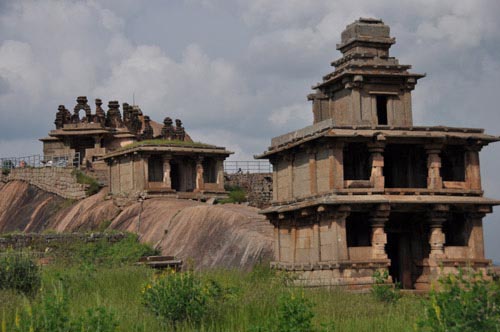Chitradurga Fort

Information on Chitradurga Fort (Chitradurga, Karnataka) - History & Architecture
Chitradurga Fort also known as the The Fort of Seven Rounds is located in the Chitradurga District of the state of Karnataka. The name of the fort i.e. Chitradurga meant the picturesque fort in Kannada language. The fort was mainly built during the reign of rulers like Rashtrakutas and Chalukyas.
Chitradurga Fort Architecture
The architecture of the fort was quite unique in its own sense. During the rule of the Nayakas the fort was designed in manner where it has 19 gateways along with 38 following entrances and 35 covert doorways to deal with the incursion of enemies. There were also ware-houses and water reservoirs which were used for storage during the time of water and food scarcity. These features of the fort are quite unique from other monument and they are still being preserved efficiently by ASI. Moreover, the seven walls within the fort were designed with thin passage to stop enemies from entering the fort to attack with elephant. There were some parts within the fort that were used by archers to attack the enemy. There were also elaborate gates within the east end of the monument that further depicts the influence of the Bahmani Sultanate. Furthermore, another striking architectural feature of the fort is the height of the walls (5-13 m) which were made in alignment with the topographical condition of the surrounding area. Subsequently, some parts of the monument were also built with the use of scorched bricks and mortar along with cement. This depicts a glimpse of modern day architecture.
Chitradurga Fort History
The monument was constructed primarily in three parts in between the period of 17-18 century. The construction of the monument started during the reign of the Rashtrakutas and completed during the rule of Nayakas. However, 'the Nayakas of Chitradurga' were mainly accountable for the extensive elongation of the monument during the 18th century. The defeat of the Nayakas by Hyder Ali in the year 1779 saw the fort going into the hands of father and son duo i.e. Hyder Ali and Tipu Sultan respectively. They further expanded the fort to larger extent. The monument is also called the 'Fort of Seven Rounds' because it was constructed involving a sequence of 7 concentric defence wall where there lies Masjid, warehouses and ancient temples among others. Altogether, there exist 18 temples within the fort with the biggest of them situated in the upper end of the monument. The most interesting and sacred out of the 18 temples is the 'Hidimbeshwara temple'. The mashed inside the fort was constructed during the supremacy of Hyder Ali. It is believed that the monument is connected with tanks to collect rain water during the time of water shortage.
Chitradurga Fort Tourism Importance
Considering its architectural importance and the uniqueness of its design, the monument can be regarded as a masterpiece in the human history. The fort is one of the biggest monuments among the 300 structures in the state of Karnataka. These aspects will encourage tourists to visit the place. Moreover, the place i.e. Chitradurga district also has effective communication channel with the city which will further help the tourist to reach the place conveniently. Additionally, since the place is quite popular amid the local people, its awareness amid the tourists can be easily ensured. All these factors will influence the tourism importance of the Fort of Seven Rounds positively.
- Bangalore Monuments
- Bagalkot Monuments
- Belgaum Monuments
- Bellary Monuments
- Bidar Monuments
- Bijapur Monuments
- Chitradurga Monuments
- Coorg Monuments
- Dakshina Kannada Monuments
- Gadag Monuments
- Gulbarga Monuments
- Hassan Monuments
- Mysore Monuments
- Raichur Monuments
- Uttara Kannada Monuments
- Yadgir Monuments
- Andaman Nicobar Monuments
- Andhra Pradesh Monuments
- Assam Monuments
- Bihar Monuments
- Chhattisgarh Monuments
- New Delhi Monuments
- Goa Monuments
- Gujarat Monuments
- Haryana Monuments
- Himachal Pradesh Monuments
- Jammu and Kashmir Monuments
- Karnataka Monuments
- Kerala Monuments
- Madhya Pradesh Monuments
- Maharashtra Monuments
- Odisha Monuments
- Punjab Monuments
- Rajasthan Monuments
- Tamil Nadu Monuments
- Telangana Monuments
- Uttar Pradesh Monuments
- West Bengal Monuments